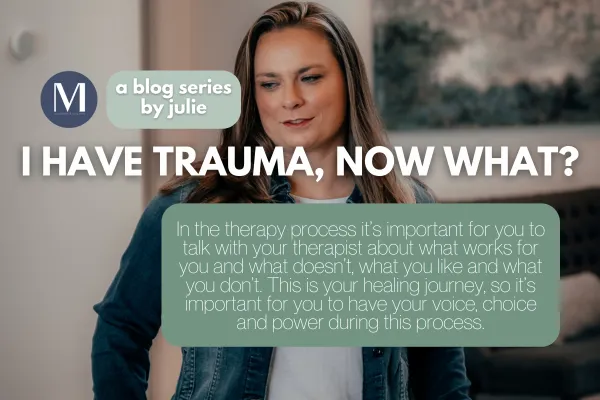the blog
A place for our team to share about topics they are passionate about, in hopes of allowing you to see and understand a bit more behind the faces on these pages.

I Have Trauma, Now What?
We’ve covered a few different types of trauma in this series, and this list is far from complete. Although, I figured that giving a snapshot into what trauma is and looks like could be a starting point for you. So now that you’ve discovered that you have trauma, you may be asking the question, “Well now what?” Let me tell you what trauma therapy can look like. It’s important to remember that each therapist will have a different approach when it comes to therapy and each person’s process, but these are some of the consistent things that you may see along the way.
First things first, safety. Safety is key: physical, emotional, and psychological. Knowing that you have a choice in the process, that you have power and you have a voice; that is key! Establishing safety within a therapeutic relationship is foundational to begin the healing journey. This can happen very quickly and sometimes it can take a very long time. It is completely dependent on each person. Throughout the safety process, there is often an attachment (going back to attachment styles) that is developed. Hopefully it is a secure attachment so that you feel safe and connected to your therapist.
Secondly, you start to learn emotional regulation skills and mindfulness, often referred to as DBT skills. DBT - Dialectical Behavioural Therapy - are skills that help you learn to identify and calm your emotions so you’re able to understand and feel in control of what’s happening. This helps as you start to navigate and talk through the trauma. You’re able to manage the emotions that come up and you don’t feel overwhelmed by them.
Thirdly, starting to talk through the story of what’s happened and how it impacts you. This can look several different ways. Sometimes it looks like talk therapy which is verbally going through what happened; sometimes to looks like somatic therapy which is allowing your body to process the emotions connected to the experience; sometimes it looks more neurological which is helping your brain rewire the belief systems that have developed from the experiences - and more often than not, it’s a combination of all three.
In the therapy process it’s important for you to talk with your therapist about what works for you and what doesn’t, what you like and what you don’t. This is your healing journey, so it’s important for you to have your voice, choice and power during this process. If you’ve been following along in our blog series and want to start to work through the trauma you’ve experienced, reach out, someone would be happy to talk with you about what this process looks like.
Office Location: 1200 Brock Street South, Whitby, ON. L1N 4L9
© Marquis Counselling & Consulting | ALL RIGHTS RESERVED | TERMS & CONDITIONS | PRIVACY POLICY

